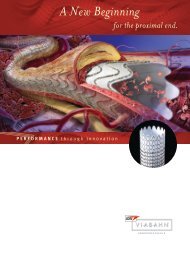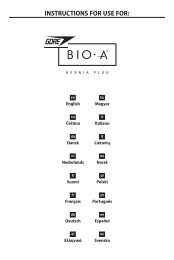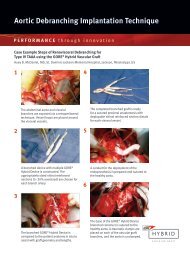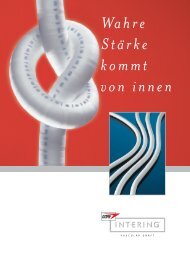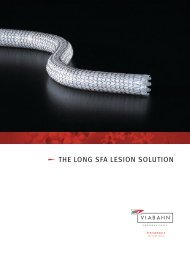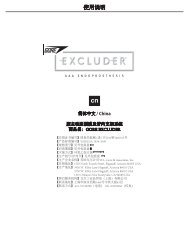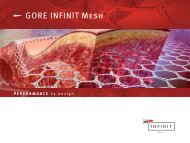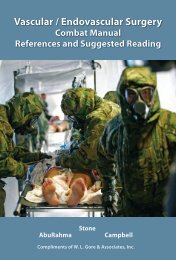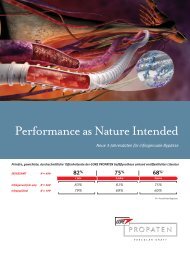FAQ Brochure - Gore Medical
FAQ Brochure - Gore Medical
FAQ Brochure - Gore Medical
Create successful ePaper yourself
Turn your PDF publications into a flip-book with our unique Google optimized e-Paper software.
FREQUENTLY ASKED QUESTIONS<br />
P E R F O R M A N C E<br />
t h r o u g h c o l l a b o r a t i o n
Table of Contents<br />
GORE ® VIABAHN ® Endoprosthesis with<br />
PROPATEN Bioactive Surface <strong>FAQ</strong>s<br />
What is the GORE ® VIABAHN ® Endoprosthesis with<br />
PROPATEN Bioactive Surface? ......................................................2<br />
What is unique about the heparin technology of the GORE ®<br />
VIABAHN ® Endoprosthesis with PROPATEN Bioactive Surface? ........3<br />
How does end-point covalent bonding of heparin differ<br />
from conventional covalent bonding of heparin and ionic<br />
bonding of heparin? ....................................................................4<br />
How long does the heparin last? ..................................................4<br />
What kind of heparin is used for the GORE ® VIABAHN ®<br />
Endoprosthesis with PROPATEN Bioactive Surface? ......................5<br />
Does the PROPATEN Bioactive Surface change the<br />
microstructure of the ePTFE? ........................................................5<br />
How many International Units (IU) of heparin are on<br />
the surface of a GORE ® VIABAHN ® Endoprosthesis with<br />
PROPATEN Bioactive Surface? ......................................................5<br />
Does heparin elute from the surface? ...........................................5<br />
Can I change my anticoagulation procedure while<br />
using the GORE ® VIABAHN ® Endoprosthesis with<br />
PROPATEN Bioactive Surface? ......................................................5<br />
Can systemic heparin be reduced while using the GORE ®<br />
VIABAHN ® Endoprosthesis with PROPATEN Bioactive Surface? ......5<br />
Can Protamine be used? ..............................................................5<br />
Can I change my patients’ post-operative antiplatelet regime? ......5<br />
What is HIT? ................................................................................6<br />
How does the presence of PROPATEN Bioactive Surface<br />
affect the risk of HIT? ...................................................................6<br />
What treatment protocol should I follow if a GORE ®<br />
VIABAHN ® Endoprosthesis with PROPATEN Bioactive<br />
Surface patient develops HIT? ......................................................6<br />
Can the GORE ® VIABAHN ® Endoprosthesis with<br />
PROPATEN Bioactive Surface be revised if it occludes? ..................7<br />
How is the device sterilized and can I resterilize it?.......................7<br />
Does the PROPATEN Bioactive Surface require<br />
any special storage requirements? ..............................................7<br />
Will post-deployment dilation of the endoprosthesis<br />
damage the PROPATEN Bioactive Surface? ...................................7<br />
What is the benefit of the PROPATEN Bioactive Surface? ...............7<br />
Who is Carmeda AB? ...................................................................7<br />
What medical devices use Carmeda BioActive Surface<br />
(CBAS ® ) technology? ...................................................................8<br />
How does the PROPATEN Bioactive Surface on the<br />
GORE ® VIABAHN ® Endoprosthesis compare to the heparin<br />
coating on the Bx VELOCITY ® Coronary Stent with HEPACOAT ® ? .....8<br />
What is the indication for the GORE ® VIABAHN ®<br />
Endoprosthesis with PROPATEN Bioactive Surface? ......................8<br />
GORE ® VIABAHN ® Endoprosthesis <strong>FAQ</strong>s<br />
What is ePTFE? ............................................................................9<br />
What clinical data exists for the<br />
GORE ® VIABAHN ® Endoprosthesis in the SFA? ..............................9<br />
Are there any clinical considerations when using<br />
the GORE ® VIABAHN ® Endoprosthesis? ........................................9<br />
What about in-stent restenosis? ................................................10<br />
Is there any Level 1 clinical data for the<br />
GORE ® VIABAHN ® Endoprosthesis? ............................................10<br />
What about SFA stent fractures with the<br />
GORE ® VIABAHN ® Endoprosthesis? ............................................10<br />
What are the potential failure modes of the<br />
GORE ® VIABAHN ® Endoprosthesis? ............................................11<br />
What is the effect of the contoured proximal edge?.....................11<br />
What is the rate of thrombosis for the<br />
GORE ® VIABAHN ® Endoprosthesis? ............................................12<br />
References ................................................................................13<br />
1
2<br />
GORE ® VIABAHN ® Endoprosthesis with<br />
PROPATEN Bioactive Surface <strong>FAQ</strong>s<br />
What is the GORE ® VIABAHN ® Endoprosthesis with PROPATEN Bioactive Surface?<br />
The GORE ® VIABAHN ® Endoprosthesis with PROPATEN Bioactive Surface is a flexible, self-expanding<br />
endoluminal endoprosthesis consisting of an expanded polytetrafluoroethylene (ePTFE) lining with<br />
an external nitinol support extending along its entire length. The surface of the endoprosthesis is<br />
modified with covalently bonded bioactive heparin (PROPATEN Bioactive Surface).<br />
• Ultra thin wall ePTFE lining<br />
• Unique, durable bonding film<br />
• Polished nitinol stent<br />
• Heparin-bonded surface<br />
• Contoured proximal edge<br />
• Lengths: 2.5, 5, 10, 15, 25 cm<br />
• Diameters: 5 – 13 mm
What is unique about the heparin technology of the<br />
GORE ® VIABAHN ® Endoprosthesis with PROPATEN Bioactive Surface?<br />
• Proprietary end-point covalent bonding<br />
• Sustained bioactivity 1<br />
• Minimal heparin elution within the first 24 hours<br />
The heparin molecules are covalently bonded to the surface through a proprietary end-point<br />
attachment mechanism (Carmeda ® BioActive Surface (CBAS ® )) which serves to anchor heparin<br />
molecules to the surface while still maintaining heparin’s intrinsic bioactive properties.<br />
The result: a surface that is intended to maintain thromboresistance over time.<br />
AT-T<br />
AT-T<br />
T<br />
A covalent end-point linkage mechanism<br />
allows bonding of the heparin molecules to the<br />
endoprosthesis while retaining heparin’s anticoagulant<br />
activity. The active site of a heparin molecule enables<br />
antithrombin (AT) to bind, thus increasing the efficiency<br />
of AT to subsequently bind to thrombin (T).<br />
When thrombin (T) binds to antithrombin (AT) an AT-<br />
T complex is formed. The neutralized thrombin loses<br />
its ability to catalyze the conversion of fibrinogen to<br />
fibrin. Consequently, fibrin (a major component of<br />
thrombus) deposition on the endoprosthesis surface<br />
is suppressed.<br />
The neutral AT-T complex detaches from the heparin<br />
molecule thus leaving the heparin bioactive site available<br />
to again bind antithrombin. The resulting catalytic cycle<br />
enables the thromboresistant process to perpetuate.<br />
3
4<br />
How does end-point covalent bonding of heparin differ from<br />
conventional covalent bonding of heparin and ionic bonding of heparin?<br />
Conventional Covalent Bonding<br />
In conventional, multiple point, covalent bonding, the anticoagulant properties of heparin are lost<br />
due to the fact that the heparin active site is not available to antithrombin.<br />
Ionic Bonding<br />
In ionic bonding, the attractive force of negatively charged heparin and positively charged coating<br />
can be easily broken, thus allowing heparin to be released from the surface over time. Sustained<br />
thromboresistance cannot be achieved.<br />
End-point Covalent Bonding<br />
How long does the heparin last?<br />
The heparin molecule (yellow) is bonded (white) at<br />
multiple points to the device surface (orange).<br />
The heparin active site (red) is unavailable to<br />
antithrombin. Without bioactivity, the anticoagulant<br />
properties of heparin are lost.<br />
The negatively (-) charged heparin molecule (yellow) is<br />
attracted to a positively (+) charged coating (orange) on the<br />
device surface. This attractive force can be broken, allowing<br />
heparin to release from the surface over time. Sustained<br />
thromboresistance cannot be achieved.<br />
End-point covalent bonding is a unique concept that allows the anticoagulant<br />
properties of heparin to be harnessed directly on the endoprosthesis surface. The<br />
end of each heparin molecule is bonded to the surface, allowing the heparin active<br />
site to freely interact with anti-thrombin. Consequently, heparin is retained on the<br />
endoprosthesis surface in a bioactive form. This results in a endoprosthesis surface<br />
with sustained thromboresistance.<br />
In order to resist thrombus build-up, it is essential that heparin is present on the surface<br />
and retains its bioactive function. While there is no specific data for the GORE ® VIABAHN ®<br />
Endoprosthesis with PROPATEN Bioactive Surface, data from other devices modified using the<br />
same proprietary end-point heparin-bonding technology gives some insight into the longevity<br />
of the heparin activity. GORE ® PROPATEN ® Vascular Graft explants from an in vivo canine model<br />
demonstrated the continued presence of heparin on the graft surface and showed sustained<br />
heparin bioactivity over a period of 12 weeks 1 . Riesenfeld has reported substantial bioactivity<br />
on Berlin Heart ventricular assist devices (same as the CBAS ® technology used on the GORE ®<br />
VIABAHN ® Endoprosthesis with PROPATEN Bioactive Surface) removed from patients after 855<br />
days 2 . Finally, a GORE ® PROPATEN ® Vascular Graft explanted after occlusion of outflow vessels after<br />
1,111 days continued to exhibit heparin activity within the original manufacturing specifications.
What kind of heparin is used for the GORE ® VIABAHN ® Endoprosthesis with PROPATEN Bioactive Surface?<br />
Reduced molecular weight heparin derived from USP heparin of porcine origin is used in the<br />
construction of the PROPPATEN Bioactive Surface.<br />
Does the PROPATEN Bioactive Surface change the microstructure of the ePTFE?<br />
The thickness of a CBAS ® coating is approximately 200 nanometers (nm) 14 . This is not sufficient to<br />
change the microstructure of the ePTFE.<br />
How many International Units (IU) of heparin are on the surface of a<br />
GORE ® VIABAHN ® Endoprosthesis with PROPATEN Bioactive Surface?<br />
Heparin activity in solution is typically measured in terms of International Units (IU). Surface<br />
bound heparin, on the other hand, is normally measured in terms of picomoles of ATIII activity.<br />
A reasonable estimate of the number of IUs on the endoprosthesis surface can be obtained via<br />
theoretical calculations. Based on the mass of heparin on the surface, theoretical calculations yield<br />
an estimate of < 400 IU per endoprosthesis (8 mm x 15 cm). This is very small compared to the<br />
typical intraoperative heparin dose of ~5,000 IU.<br />
Does heparin elute from the surface?<br />
The GORE ® VIABAHN ® Endoprosthesis with PROPATEN Bioactive Surface binds heparin to the<br />
endoprosthesis surface via a stable covalent linkage. In vitro experiments performed on the<br />
GORE ® VIABAHN ® Endoprosthesis with PROPATEN Bioactive Surface have shown that less than 30<br />
IU of heparin are released into solution during the first 24 hours after initiation of flow (data on<br />
file). Thereafter, there is minimal release of heparin and no systemic effect.<br />
Can I change my anticoagulation procedure while using the<br />
GORE ® VIABAHN ® Endoprosthesis with PROPATEN Bioactive Surface?<br />
The physician should consider the need for intraoperative and / or postoperative anticoagulation<br />
therapy based on the pharmacological requirements and medical history of the patient.<br />
The presence of heparin on the endoprosthesis is not intended to serve as an alternative to<br />
the surgeon’s chosen intraoperative or postoperative anticoagulation regimens.<br />
Can systemic heparin be reduced while using the<br />
GORE ® VIABAHN ® Endoprosthesis with PROPATEN Bioactive Surface?<br />
The presence of heparin on the GORE ® VIABAHN ® Endoprosthesis with PROPATEN Bioactive Surface<br />
is not intended to serve as an alternative to intraoperative or postoperative anticoagulation.<br />
The anticoagulant effect of the heparin on the endoprosthesis is limited to the device surface<br />
and does not have a systemic anticoagulant effect.<br />
Can protamine be used?<br />
There is no long-term effect by protamine on the bioactivity of the PROPATEN Bioactive Surface.<br />
Although protamine reverses the anticoagulant activity of heparin, its effect is transitory.<br />
Protamine can only remain bound to heparin when it is present in sustained excess quantities.<br />
Since protamine is rapidly removed from the circulation, any effect is short-lived, as protamine<br />
desorbs from the endoprosthesis surface into the blood stream.<br />
Can I change my patients’ post-operative antiplatelet regime?<br />
The presence of heparin on the GORE ® VIABAHN ® Endoprosthesis with PROPATEN Bioactive Surface<br />
is not intended to serve as an alternative to the physician’s chosen postoperative antiplatelet<br />
regimens. The post-operative antiplatelet regimen is left at the discretion of the physician.<br />
5
6<br />
What is HIT?<br />
Heparin-Induced Thrombocytopenia (HIT) occurs in a relatively small subset of the patient<br />
population and is defined as a decrease in platelet count during or shortly following exposure to<br />
heparin3 . There are two distinct types of HIT, each with very different clinical ramifications.<br />
HIT type I is characterized by a mild and transient asymptomatic thrombocytopenia that develops<br />
within the first few days of starting heparin treatment and disappears quickly following heparin<br />
cessation4 . This type of HIT is benign and is not associated with an increased risk of thrombosis.<br />
HIT type II is characterized by rapid or delayed-onset thrombocytopenia that is associated with<br />
a risk of thrombosis5 . In the following discussion, HIT type II will be referred to simply as HIT.<br />
The mechanism underlying HIT is an immune response as antibodies are formed against a<br />
heparin-platelet factor 4 (PF4) complex. The antibody-heparin-PF4 immunocomplex binds to<br />
platelets, inducing platelet activation and aggregation. Thrombocytopenia results from the clearance<br />
of activated platelets and antibody-coated platelets by the reticulo-endothelial system5, 6 . Typically,<br />
patients receiving heparin for the first time experience the onset of thrombocytopenia 5 – 8 days after<br />
the administration of heparin; however, the onset can be rapid (< 1 day) in patients with antibodies<br />
from a previous exposure7, 8 or delayed up to 3 weeks after heparin therapy has stopped9-12 .<br />
How does the presence of PROPATEN Bioactive Surface affect the risk of HIT?<br />
The GORE ® VIABAHN ® Endoprosthesis with PROPATEN Bioactive Surface is contraindicated for<br />
patients with known hypersensitivity to heparin, including those patients who have had a previous<br />
incidence of HIT type II.<br />
For patients who do not have a known hypersensitivity to heparin, the theoretical potential of any<br />
heparin bonded device to cause platelet aggregation and thrombocytopenia does exist. However,<br />
since interventions in the vascular system almost invariably involve administration of systemic<br />
heparin, it becomes difficult, if not impossible, to judge whether or not the heparin bonded device<br />
contributed to the development of HIT.<br />
The body of clinical evidence to date for the PROPATEN Bioactive Surface does not show any<br />
relationship between the implantation of this product and HIT. In a study by Heyligers, et al13 ,<br />
HIT-inducing antibodies were not detected in any of the patients that received the GORE ®<br />
PROPATEN ® Vascular Graft even after six weeks of implantation.<br />
The incidence of reported cases of HIT after implantation of the GORE ® PROPATEN ® Vascular Graft<br />
is less than 0.1% worldwide. It is not known if the graft contributed to the development of HIT in<br />
these patients.<br />
The GORE ® VIABAHN ® Endoprosthesis with PROPATEN Bioactive Surface does not elute heparin<br />
into the bloodstream and hence has no systemic effect. Based on the mass of heparin on the<br />
surface of the endoprosthesis, theoretical calculations yield an estimate of < 400 IU of heparin per<br />
endoprosthesis (8 mm x 15 cm). This is very small compared to the typical intraoperative heparin<br />
dose of ~5,000 IU.<br />
What treatment protocol should I follow if a GORE ® VIABAHN ® Endoprosthesis<br />
with PROPATEN Bioactive Surface patient develops HIT?<br />
The incidence of HIT type II is extremely low in vascular bypass patients receiving heparin over a<br />
period of several days. If HIT type II is diagnosed, established procedures for the treatment of this<br />
condition, including immediate cessation of systemic heparin administration, should be followed.<br />
If symptoms persist, or the health of the patient appears compromised, alternative pharmaceutical<br />
or surgical procedures, including surgical bypass and / or removal of the endoprosthesis, may be<br />
considered at the discretion of the attending physician.<br />
The incidence of reported cases of HIT after the implantation of the GORE ® PROPATEN ® Vascular<br />
Graft is less than 0.1%. It is not known if the graft contributed to the development of HIT.
Can the GORE ® VIABAHN ® Endoprosthesis with PROPATEN Bioactive Surface be revised if it occludes?<br />
The GORE ® VIABAHN ® Endoprosthesis with PROPATEN Bioactive Surface can be revised like the<br />
non-heparin bonded GORE ® VIABAHN ® Endoprosthesis. Bioactivity of the PROPATEN Bioactive<br />
Surface after a revision procedure has not been established.<br />
How is the device sterilized and can I resterilize it?<br />
The device is sterilized using Ethylene Oxide. The GORE ® VIABAHN ® Endoprosthesis with PROPATEN<br />
Bioactive Surface should not be resterilized.<br />
Does the PROPATEN Bioactive Surface require any special storage requirements?<br />
The PROPATEN Bioactive Surface does have susceptibility to humidity. However, the foil pouch is<br />
both a moisture and a sterile barrier, and sufficiently protects the device from humidity. DO NOT<br />
use or store the device if the foil pouch has been compromised. The package should be stored in a<br />
cool dry place (the shelf of a cath lab is fine). The product does have an expiration date and should<br />
be used before the labeled “use by” (expiration) date marked on the box.<br />
Will post-deployment dilation of the endoprosthesis damage the PROPATEN Bioactive Surface?<br />
The PROPATEN Bioactive Surface is designed to withstand balloon touch up. In vitro tests show<br />
that balloon touch up with the appropriately sized balloon will not affect the activity of the heparin<br />
surface (data on file).<br />
What is the benefit of the PROPATEN Bioactive Surface?<br />
While there is no direct clinical evidence to indicate that the PROPATEN Bioactive Surface has<br />
an affect on the effectiveness of the GORE ® VIABAHN ® Endoprosthesis, the Carmeda ® BioActive<br />
Surface (CBAS ® ), upon which PROPATEN Bioactive Surface is based, has a long clinical history.<br />
Some of the reported features and benefits of the CBAS ® bioactive coating technology include:<br />
long-term bioactivity, non-leaching, reduced thrombus formation / platelet adhesion, decreased<br />
inflammatory response, and antimicrobial protection 14 .<br />
Who is Carmeda AB?<br />
Carmeda AB, a Swedish company, invented the end-point heparin bonding technology used on the<br />
GORE ® VIABAHN ® Endoprosthesis with PROPATEN Bioactive Surface and other medical devices.<br />
This end-point heparin bonding technology is termed the Carmeda ® BioActive Surface (CBAS ® ).<br />
Carmeda AB is a world leader in heparin technology with a long history of pioneering research in<br />
this field since the company was founded in 1984. In October, 2005, Carmeda AB became a wholly<br />
owned subsidiary of W. L. <strong>Gore</strong> & Associates, Inc.<br />
7
8<br />
What medical devices use Carmeda ® BioActive Surface (CBAS ® ) technology?<br />
Carmeda AB has developed several successful partnerships with companies that manufacture<br />
medical devices such as coronary stents, oxygenator circuits, ventricular assist devices, blood<br />
gas sensors and central venous catheters. Over 200 scientific papers including numerous clinical<br />
studies have demonstrated the safety, efficacy and superiority of the CBAS ® technology.<br />
The reported features and benefits of the CBAS ® bioactive coating technology include: long-term<br />
bioactivity, non-leaching, reduced thrombus formation / platelet adhesion, decreased inflammatory<br />
response, and antimicrobial protection14 .<br />
The GORE ® PROPATEN ® Vascular Graft utilizes the same process used to create the PROPATEN<br />
Bioactive Surface. Since its 2002 market introduction in the European Union and in several<br />
countries worldwide, the GORE ® PROPATEN ® Vascular Graft has been used in several peripheral<br />
applications including lower extremity revascularization. Several prospective and retrospective<br />
studies undertaken thus far support the safety and efficacy of the GORE ® PROPATEN ® Vascular<br />
Graft15 .<br />
How does the PROPATEN Bioactive Surface on the GORE ® VIABAHN ® Endoprosthesis<br />
compare to the heparin coating on the Bx VELOCITY ® Coronary Stent with HEPACOAT ® ?<br />
Although these devices have different indications and therefore cannot be directly compared,<br />
the heparin surface on both devices utilizes the same CBAS ® technology to create a permanent,<br />
bioactive heparin surface. However, there are two distinct differences between a heparin-bonded<br />
stent and a heparin-bonded stent-graft: the amount of lesion coverage provided by the coated<br />
device and the length of time that the surface is exposed to the blood stream.<br />
Lesion coverage Placement of a coated bare stent leaves a substantial part of the diseased vessel<br />
lumen exposed. The effect of the surface-bound heparin is limited to the stent struts and not the<br />
entire stented region. However, the GORE ® VIABAHN ® Endoprosthesis with PROPATEN Bioactive<br />
Surface completely lines the diseased vessel. The surface-bound heparin is present throughout the<br />
treated region.<br />
Exposure time Bare coronary stents rapidly re-endothelialize following implantation16 . Thus, within<br />
weeks after implantation, any heparin bound to the stent struts would be masked by neointimal<br />
and endothelial cells, rendering it irrelevant. In contrast, the ePTFE lining of the GORE ® VIABAHN ®<br />
Endoprosthesis with PROPATEN Bioactive Surface inhibits cellular infiltration, thus leaving the<br />
heparin exposed and bioactive. Studies of an ePTFE vascular graft with the same heparin coating<br />
have shown sustained heparin bioactivity out to at least 3 months1 . Riesenfeld has reported<br />
substantial bioactivity on a CBAS ® -coated Berlin Heart ventricular assist devices (same as the<br />
CBAS ® technology used on the GORE ® VIABAHN ® Endoprosthesis with PROPATEN Bioactive Surface)<br />
removed from patients after 855 days2 . Finally, a GORE ® PROPATEN ® Vascular Graft explanted<br />
after occlusion of outflow vessels after 1,111 days continued to exhibit heparin activity within the<br />
original manufacturing specifications. Theoretically, as long as the endoprosthesis is free from<br />
neointimal or pseudo intimal overgrowth, the heparin is available and active.<br />
What is the indication for the GORE ® VIABAHN ® Endoprosthesis with PROPATEN Bioactive Surface?<br />
The GORE ® VIABAHN ® Endoprosthesis with PROPATEN Bioactive Surface is a flexible, selfexpanding<br />
endoluminal prosthesis for endovascular grafting of peripheral arteries.
GORE ® VIABAHN ® Endoprosthesis <strong>FAQ</strong>s<br />
What is ePTFE?<br />
ePTFE is an acronym for expanded polytetrafluoroethylene. PTFE is an extremely inert,<br />
biocompatible biomaterial composed solely of carbon and fluorine. When PTFE is expanded at a<br />
high temperature and rate, ePTFE is formed with a node-fibril microstructure. This discovery was<br />
made by Bob <strong>Gore</strong> in 1969. Since the mid-1970’s, ePTFE vascular grafts have been the synthetic<br />
material of choice by vascular surgeons performing peripheral bypass operations or creating<br />
dialysis access grafts.<br />
What clinical data exists for the GORE ® VIABAHN ® Endoprosthesis in the SFA?<br />
The GORE ® VIABAHN ® Endoprosthesis has an impressive amount of published clinical data. There have<br />
been 17 independent studies reporting primary patency for the endoprosthesis with greater than 30<br />
patients. For the published 1103 limbs, with an average lesion length of 16 cm, the weighted average<br />
one year primary patency is 77%.<br />
Reported Patencies of GORE ® VIABAHN ® Endoprosthesis /<br />
GORE ® HEMOBAHN ® Endoprosthesis (5 – 8mm) treating the SFA in Studies of at least 30 limbs<br />
Author Year Journal Publication / Presentation<br />
No. of<br />
Limbs<br />
Lesion<br />
Length<br />
(cm)<br />
%<br />
Occlusions<br />
Primary Patency<br />
(years / %)<br />
1 2 3 4<br />
Lammer 2000 Radiology, 217:95-104 80 13.8 NR 79<br />
Jahnke 2003 J Vasc Interv Radiol, 14:41-51 52 8.5 83 78 74 62<br />
Bleyn 2004 Edizioni Minerva Medica, 14:87-91 67 14.3 100 82 73 68 54<br />
Panetta 2005 Endovasc Today, August 41 30.4 90 86 77<br />
Chopra 2006 AIM Symposium, November 13 – 16 70 20 71 93 87 72<br />
Coats 2006 Endovasc Today, September 83 NR 47 89<br />
Fischer 2006 J Endovasc Ther, 13:281-290 59 10.7 87 67 58 57 52<br />
Zander 2006 SIR Meeting, April 3 31 16.6 NR 86 78 78 78<br />
Saxon 2007 J Vasc Interv Radiol, 18:1341-1350 87 14.2 42 76 65 60 55<br />
Alimi 2008 Eur J Vasc Endovasc Surg, 35:346-352 102 11.7 NR 74 71 71<br />
Djelmami-Hani 2008 SCAI Meeting, March 29 – April 1 132 21 39 80<br />
Saxon 2008 J Vasc Interv Radiol, 18:823-832 97 7 21 65<br />
VIBRANT 2009 VIVA, September 19 – 22 72 19 60 53<br />
Kougias 2009 Am J Surgery, 198:645-649 31 23 100 75<br />
Farraj 2009 J Invasive Cardiol, 21:278-281 32 15.4 100 80<br />
Rebellino 2009 Cath Cardiovasc Interv, 73:701-705 32 NR NR 82 75 75 75<br />
McQuade 2010 J Vasc Surg, 52:584-591 50 25.6 NR 72 63 63 59<br />
Average / Total<br />
NR = Not Reported<br />
1103 16.1 62 77 72 67 59<br />
Are there any clinical considerations when using the GORE ® VIABAHN ® Endoprosthesis?<br />
Some key clinical learnings that have emerged include:<br />
• Avoid non-compliant lesions<br />
• Ensure adequate inflow and outflow (i.e., at least one vessel run-off)<br />
• Correct sizing is key<br />
• Land device at least 1 cm into healthy vessel proximally and distally to the lesion<br />
• Every region pre-treated with PTA needs to be covered by the device<br />
• During post dilatation, only balloon inside the region covered by the device<br />
• Consider an antiplatelet regimen post-procedure<br />
• Do not use the GORE ® VIABAHN ® Endoprosthesis with PROPATEN Bioactive Surface in patients<br />
with known hypersensitivity to heparin, including those patients who have had a previous<br />
incidence of Heparin-Induced Thrombocytopenia (HIT) type II.<br />
9
10<br />
What about in-stent restenosis?<br />
The ePTFE lining of the GORE ® VIABAHN ® Endoprosthesis limits in-stent restenosis, and because of<br />
this, patency is independent of lesion length. For the studies presented in the table above, a plot<br />
of the 1 year primary patency versus lesion length (17 studies, 1103 limbs) shows that patency is<br />
indeed independent of lesion length.<br />
1 Year Primary Patency<br />
100%<br />
80%<br />
60%<br />
40%<br />
20%<br />
0%<br />
0 5 10<br />
15 20 25 30 35<br />
Average Lesion Length Treated (cm)<br />
Is there any Level 1 clinical data for the GORE ® VIABAHN ® Endoprosthesis?<br />
There are 2 published studies that present Level 1 clinical data for the GORE ® VIABAHN ®<br />
Endoprosthesis.<br />
From 1998 – 1999, the GORE ® VIABAHN ® Endoprosthesis was evaluated in a randomized,<br />
multicenter trial, and published in the Journal of Vascular and Interventional Radiology in 200828 .<br />
The purpose of the study was to compare the safety and effectiveness of the GORE ® VIABAHN ®<br />
Endoprosthesis to percutaneous transluminal angioplasty (PTA) in patients with chronic lower<br />
limb ischemia or chronic lifestyle altering claudication due to superficial femoral artery (SFA)<br />
atherosclerotic disease. A total of 241 patients or 244 cases (limbs) were treated in the study. Each<br />
site was permitted up to two training cases. A total of 47 training cases were performed; 197 cases<br />
were randomized with 100 assigned to PTA and 97 to the GORE ® VIABAHN ® Device. The GORE ®<br />
VIABAHN ® Endoprosthesis showed 25% better 12-month redefined primary patency than PTA: 65%<br />
vs. 40%. Patency in this study was defined as target vessel, not target lesion, patency (PSVR < 2.0<br />
via DUS at 12 months).<br />
A second study was published in the Journal of Vascular Surgery by McQuade et al33 in 2010. In this<br />
randomized, single center study, the GORE ® VIABAHN ® Endoprosthesis was compared to prosthetic<br />
fem-pop surgical bypass in treating superficial femoral artery occlusive disease. Fifty limbs were<br />
enrolled into each study arm with ankle-brachial indices and color duplex flow sonography imaging<br />
performed at 3, 6, 9, 12, 18, 24, 36, and 48 months. The primary patency rate for the stent graft<br />
group at 12, 24, 36, and 48 months was 72%, 63%, 63%, and 59%, respectively, while the primary<br />
patency for the surgical bypass group was 76%, 63%, 63%, and 58%, respectively,The average<br />
treatment length was 25.6 cm for the GORE ® VIABAHN ® Endoprosthesis.<br />
What about SFA stent fractures with the GORE ® VIABAHN ® Endoprosthesis?<br />
The device has excellent flexibility and is well-suited for the SFA. There is a very low incidence<br />
(
What are the potential failure modes of the GORE ® VIABAHN ® Endoprosthesis?<br />
Although primary patency at 1 year is excellent (77%), the literature does report some failure<br />
modes and how they can be mitigated. Examples include:<br />
Failure Mode Mitigators<br />
Edge Restenosis Don’t balloon outside the device; properly oversize the device (5 – 20%)<br />
Progression of Disease Cover all of the diseased vessel; distal and proximal landing zones should be in healthy vessel<br />
Thrombosis Complete post-dilatation; appropriate antiplatelet therapy; regular patient follow-up<br />
What is the effect of the contoured proximal edge?<br />
The contoured proximal edge is a manufacturing change that was implemented to improve<br />
repeatability in processing, and leads to improved apposition of the device to the vessel wall. The<br />
conformable fit of the stent-graft may improve flow dynamics at the proximal edge of the stent.<br />
11
12<br />
What is the rate of thrombosis for the GORE ® VIABAHN ® Endoprosthesis?<br />
There are two thrombosis events to consider: acute and late.<br />
Acute Thrombosis (< 30 days of procedure). As reported in the literature, the GORE ® VIABAHN ®<br />
Endoprosthesis has an acute thrombosis rate of 2 – 5% 17, 19, 34, 35 . This is similar to the 3 – 4% acute<br />
thrombosis rates of bare nitinol stents36, 37 . Thus, this acute thrombosis rate is likely procedure related<br />
rather than related to any inherent thrombogenicity of the device.<br />
Late Thrombosis (> 30 days of procedure). If a GORE ® VIABAHN ® Endoprosthesis fails, it may present<br />
itself as a thrombosed endoprosthesis. Often this is secondary to another failure mode (edge stenosis<br />
or disease progression) and a result of low blood flow through the endoprosthesis. The occluded<br />
endoprosthesis can be revised, and the adjacent disease treated using an additional endoprosthesis.<br />
The long-term patency of the GORE ® VIABAHN ® Endoprosthesis at 5 years in a selected patient<br />
population was recently reported to be 62% (primary patency) and 90% (secondary patency) by<br />
Fischer, et al 23 . This secondary patency demonstrates the durability and patency of the endoprosthesis<br />
after revision.<br />
Occluded<br />
GORE ® VIABAHN ® Device<br />
(arrow indicates<br />
proximal edge of device)<br />
Images courtesy of Richard Saxon<br />
After lysis,<br />
edge stenosis apparent PTA of the edge stenosis
References<br />
1. Begovac PC, Thomson RC, Fisher JL, Hughson A, Gällhagen A. Improvements in GORE-TEX ® Vascular Graft performance by Carmeda ® bioactive surface heparin<br />
immobilization. European Journal of Vascular and Endovascular Surgery 2003;25(5):432-437.<br />
2. Riesenfeld J, Ries D, Hetzer R. Analysis of the heparin coating of an EXCOR ® Ventricular Assist Device after 855 days in a patient. Abstract presented at the 32nd Society<br />
for Biomaterials Annual Meeting. April 18-21, 2007. Chicago, IL. Abstract 180.<br />
3. Warkentin TE. An overview of the heparin-induced thrombocytopenia syndrome. Seminars in Thrombosis & Hemostasis 2004;30(3):273-283.<br />
4. Franchini M. Heparin-induced thrombocytopenia: an update. Thrombosis Journal 2005;3(1):14-18.<br />
5. Jang IK, Hursting MJ. When heparins promote thrombosis: review of heparin-induced thrombocytopenia. Circulation 2005;111(20):2671-2683.<br />
6. Chong BH. Heparin-induced thrombocytopenia. Journal of Thrombosis & Haemostasis 2003;1(7):1471-1478.<br />
7. Lubenow N, Kempf R, Eichner A, Eichler P, Carlsson LE, Greinacher A. Heparin-induced thrombocytopenia: temporal pattern of thrombocytopenia in relation to initial<br />
use or reexposure to heparin. Chest 2002;122(1):37-42.<br />
8. Warkentin TE, Kelton JG. Temporal aspects of heparin-induced thrombocytopenia. New England Journal of Medicine 2001;344(17):1286-1292.<br />
9. Jackson MR, Neilson WJ, Lary M, Baay P, Web K, Clagett GP. Delayed-onset heparin-induced thrombocytopenia and thrombosis after intraoperative heparin<br />
anticoagulation-four case reports. Vascular & Endovascular Surgery 2006;40(1):67-70.<br />
10. Rice L, Attisha WK, Drexler A, Francis JL. Delayed-onset heparin-induced thrombocytopenia. Annals of Internal Medicine 2002;136(3):210-215.<br />
11. Smythe MA, Stephens JL, Mattson JC. Delayed-onset heparin-induced thrombocytopenia. Annals of Emergency Medicine 2005;45(4):417-419.<br />
12. Warkentin TE, Kelton JG. Delayed-onset heparin-induced thrombocytopenia and thrombosis. Annals of Internal Medicine 2001;135(7):502-506.<br />
13. Heyligers JMM, Lisman T, Verhagen HJM, Weeterings C, de Groot PhG, Moll FL. A heparin-bonded vascular graft generates no systemic effect on markers of<br />
haemostasis activation or detectable HIT-inducing antibodies in humans. In: Heyligers JMM, ed. Novel Strategies To Improve the Patency of Vascular Prostheses.<br />
2006;7:95-108.<br />
14. Carmeda AB. 2000. CBAS TM Compendium. Upplands Väsby, Sweden. Rev 2.<br />
15. Bosiers M, Deloose K, Verbist J, et al. Heparin-bonded expanded polytetrafluoroethylene vascular graft for femoropopliteal and femorocrural bypass grafting:<br />
1-year results. Journal of Vascular Surgery 2006;43(2):313-319.<br />
16. Finn AV, Nakazawa G, Joner M, et al. Vascular responses to drug eluting stents: importance of delayed healing.<br />
Arteriosclerosis, Thrombosis, & Vascular Biology 2007;27(7):1500-1510.<br />
17. Lammer J, Dake MD, Bleyn J, et al. Peripheral arterial obstruction: prospective study of treatment with a transluminally placed self-expanding stent graft. Radiology<br />
2000;217(1):95-104.<br />
18. Jahnke T, Andresen R, Müller-Hülsbeck S, et al. Hemobahn stent-grafts for treatment of femoropopliteal arterial obstructions: midterm results of a prospective trial.<br />
Journal of Vascular & Interventional Radiology 2003;14:41-51.<br />
19. Bleyn J, Schol F, Vamnhandenhove I, Vercaeren P, Marien C. Endovascular reconstruction of the superficial femoral artery. In: Becquemin JP, Alimi YS, Watelet J,<br />
Loisance D, eds. Controversies and Updates in Vascular & Cardiac Surgery. Torino, Italy. Minerva Medica;2004;14:87-91.<br />
20. Panetta TF. Endovascular femoropopliteal bypass with multiple stent grafts. Endovascular Today 2005;4(8):Supplement:12-14.<br />
21. Chopra P. Endoluminal femoropopliteal bypass using the Viabahn Stent Graft (Endograft): primary and secondary patency in 60 patients (70 limbs) with 3-year<br />
follow-up. Abstract presented at the 14th Annual Advanced Interventional Management Symposium. (AIMS) November 13-16, 2006. New York, NY. Page II 2.1.<br />
22. Coats RD, Adams Jr. JG, Humphrey PW. SFA revascularization using the Viabahn Endoprosthesis. Endovascular Today 2006;5(9):76-78.<br />
23. Fischer M, Schwabe C, Schulte K-L. Value of the Hemobahn/Viabahn Endoprosthesis in the treatment of long chronic lesions of the superficial femoral artery:<br />
6 years of experience. Journal of Endovascular Therapy 2006;13:281-290.<br />
24. Zander T, Llorens R, Rostagno R, Zerolo I, Rabellino N, Maynar M. Hemobahn/Viabahn endograft for long SFA lesions. Long term follow up. Abstract presented at the SIR<br />
31st Annual Scientific Meeting. Toronto, Ontario, Canada. March 30-April 4, 2006. Journal of Vascular & Interventional Radiology 2006;17(2)Part 2:S57.<br />
25. Saxon RR, Coffman JM, Gooding JM, Ponec DJ. Long-term patency and clinical outcome of the Viabahn Stent-Graft for femoropopliteal artery obstructions. Journal<br />
of Vascular & Interventional Radiology 2007;18(11):1341-1350.<br />
26. Alimi YS, Hakam Z, Hartung O, et al. Efficacy of Viabahn ® in the treatment of severe superficial femoral artery lesions: which factors influence long-term patency?<br />
European Journal of Vascular & Endovascular Surgery 2008;35(3):346-352.<br />
27. Djelmami-Hani M, Museitif R, Taha M, et al. VIABAHN Stent-Graft for percutaneous revascularization of long, complex lesions (TASC C/D) of superficial femoral artery.<br />
Abstract presented at the SCAI Annual Scientific Sessions in Partnership with ACC i2 Summit, The SCAI Annual Scientific Sessions in Partnership with ACC i2 Summit;<br />
March 29-April 1, 2008; Chicago, IL. Journal of the American College of Cardiology 2008;51(10)Supplement 2:B76. Abstract #2900-232.<br />
28. Saxon RR, Dake MD, Volgelzang RL, Katzen BT, Becker GJ. Randomized, multicenter study comparing expanded polytetrafluoroethylene-covered endoprosthesis<br />
placement with percutaneous transluminal angioplasty in the treatment of superficial femoral artery occlusive disease. Journal of Vascular & Interventional<br />
Radiology 2008;19(6):823-832.<br />
29. Ansel G. Vibrant one-year interim results. Presented at VIVA 2009. Las Vegas, Nevada.<br />
30. Kougias P, Chen A, Cagiannos C, Bechara CF, Huynh TT, Lin PH. Subintimal placement of covered stent versus subintimal balloon angioplasty in the treatment of<br />
long-segment superficial femoral artery occlusion. American Journal of Surgery 2009;198(5): 645-649.<br />
31. Farraj N, Srivastava A, Pershad A. One-year outcomes for recanalization of long superficial femoral artery chronic total occlusions with the Viabahn stent graft.<br />
Journal of Invasive Cardiology 2009;21(6):278-281.<br />
32. Rabellino M, Zander T, Baldi S, et al. Clinical follow-up in endovascular treatment for TASC C-D lesions in femoro-popliteal segment. Catheterization &<br />
Cardiovascular Interventions 2009;73(5):701-705.<br />
33. McQuade K, Gable D, Pearl G, Theune B, Black S. Four-year randomized prospective comparison of percutaneous ePTFE/nitinol self-expanding stent graft versus<br />
prosthetic femoral-popliteal bypass in the treatment of superficial femoral artery occlusive disease. Journal of Vascular Surgery 2010;52(3):584-591.<br />
34. Bauermeister G. Endovascular stent-grafting in the treatment of superficial femoral artery occlusive disease. Journal of Endovascular Therapy 2001;8(3):315-320.<br />
35. Saxon RR, Coffman JM, Gooding JM, Ponec DJ. Stent-graft use in the femoral and popliteal arteries. Techniques in Vascular and Interventional Radiology 2004;7(1):6-15.<br />
36. Duda SH, Bosiers M, Lammer J, et al. Sirolimus-eluting versus bare nitinol stent for obstructive superficial femoral artery disease: the SIROCCO II trial. Journal of<br />
Vascular & Interventional Radiology 2005;16(3):331-338.<br />
37. Schillinger M, Sabeti S, Loewe C, et al. Balloon angioplasty versus implantation of nitinol stents in the superficial femoral artery. New England Journal of Medicine<br />
2006;354(18):1879-1888.<br />
13
W. L. <strong>Gore</strong> & Associates, Inc.<br />
Flagstaff, AZ 86004<br />
+65.67332882 (Asia Pacific)<br />
00800.6334.4673 (Europe)<br />
800.437.8181 (United States)<br />
928.779.2771 (United States)<br />
goremedical.com<br />
Products listed may not be available in all markets.<br />
GORE ® , GORE-TEX ® , HEMOBAHN ® , PERFORMANCE THROUGH COLLABORATION, PROPATEN ® , VIABAHN ® , and designs are trademarks of W. L. <strong>Gore</strong> & Associates.<br />
CARMEDA ® and CBAS ® are trademarks of Carmeda AB, a wholly owned subsidiary of W. L. <strong>Gore</strong> & Associates.<br />
Bx VELOCITY ® and HEPACOAT ® are registered trademarks of Cordis Corporation.<br />
© 2007 – 2009, 2011 W. L. <strong>Gore</strong> & Associates, Inc. AL0748-EU3 FEBRUARY 2011




